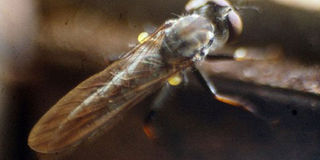Scientists move closer to ending sleeping sickness

A tsetse fly craws on a piece of wood in Mt Kenya forest on June 17, 2009. Scientists have made a breakthrough that could lead to the eradication of the African sleeping sickness or Nagana that is spread by tsetse flies. PHOTO/JOSEPH KANYI
What you need to know:
- The precise knowledge of the insect’s biology and physiology promises to yield powerful genetic tools that could one day eliminate the disease from sub-Saharan Africa, the researchers said in an article published in the journal Science last month.
Scientists have made a breakthrough that could lead to the eradication of the African sleeping sickness or Nagana that is spread by tsetse flies.
The Kenyan and foreign scientists at the International Centre of Insect Physiology and Ecology (Icipe) say they have completely mapped out the fly’s genome (complete set of DNA) key in its eradication.
The precise knowledge of the insect’s biology and physiology promises to yield powerful genetic tools that could one day eliminate the disease from sub-Saharan Africa, the researchers said in an article published in the journal Science last month.
“This is a major milestone for the tsetse fly research community,” said Geoffrey Attardo, a research scientist at the Yale School of Public Health in the United States and the lead author on the paper.
“Our hope is that this resource will facilitate functional research and be an ongoing contribution to the vector biology community.”
Yale School of Public Health Professor Serap Aksoy helped initiate the collaborative research project in the early 2000s when she and a small group of researchers concluded that progress against the disease could be made when the biological and chemical features of the organism were completely understood.
“Our hope is that tsetse research will now enjoy broader participation from the vector community and lead to improved and novel methods to eliminate disease,” Prof Aksoy said.
Head of Molecular Biology and Bioinformatics at Icipe Dan Masiga said one finding that would potentially boost tsetse fly control was the discovery of congregata and cotesia, DNA material closely related to viruses found in parasitic wasps.
He pointed out to the discovery of olfactory receptors in the genome that trigger “mating deterrence” from females as a potential tool in tsetse fly control.
Official reports
Official reports show that new infections of sleeping sickness in humans dropped to below 10,000 per year, but many cases have not been diagnosed, according to the World Health Organisation.
Actual cases have been estimated to be 20,000 and about 70 million people in 36 African countries are at risk.
BACKGROUND
Disease is vector-borne
Vector: Sleeping sickness mainly transmitted through the bite of an infected tsetse fly but can also be transferred from mother to unborn child through the placenta.
Mechanical means: Accidental infections have occurred in laboratories due to pricks from contaminated needles.




